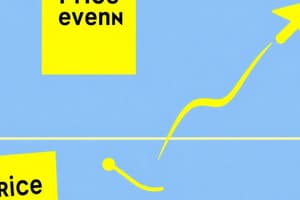Podcast
Questions and Answers
A retailer advertises a very low price on a television to attract customers, but once they arrive, the retailer attempts to persuade them to buy a more expensive model. Which pricing tactic is the retailer using?
A retailer advertises a very low price on a television to attract customers, but once they arrive, the retailer attempts to persuade them to buy a more expensive model. Which pricing tactic is the retailer using?
- Penetration pricing
- Price skimming
- Leader pricing (loss-leader pricing)
- Bait pricing (correct)
A company determines the sales volume required to cover all costs and make no profit. This calculation is an example of:
A company determines the sales volume required to cover all costs and make no profit. This calculation is an example of:
- Break-even analysis (correct)
- Base price
- Market share
- Return on Investment (ROI)
Which of the following describes a situation where consumer demand significantly changes in response to price fluctuations?
Which of the following describes a situation where consumer demand significantly changes in response to price fluctuations?
- Fixed cost
- Inelastic demand
- Dynamic pricing
- Elastic demand (correct)
A company uses software to adjust prices in real-time based on competitor prices and consumer demand. This is an example of:
A company uses software to adjust prices in real-time based on competitor prices and consumer demand. This is an example of:
A retailer offers a discount to customers who pay their bill within 10 days. This discount is an example of a:
A retailer offers a discount to customers who pay their bill within 10 days. This discount is an example of a:
Which pricing tactic involves charging freight from a specific location, regardless of where the goods are actually shipped from?
Which pricing tactic involves charging freight from a specific location, regardless of where the goods are actually shipped from?
What type of discount is offered to wholesalers and retailers for performing various channel functions?
What type of discount is offered to wholesalers and retailers for performing various channel functions?
A product's price is doubled from its cost. This pricing strategy is known as:
A product's price is doubled from its cost. This pricing strategy is known as:
A store sells bread at a low price to attract customers, hoping they will purchase other items with higher profit margins. This is an example of:
A store sells bread at a low price to attract customers, hoping they will purchase other items with higher profit margins. This is an example of:
Which of the following describes a discount applied to the total purchases made by a buyer over a specific period?
Which of the following describes a discount applied to the total purchases made by a buyer over a specific period?
Which pricing strategy involves setting a relatively low initial price to quickly gain mass-market share?
Which pricing strategy involves setting a relatively low initial price to quickly gain mass-market share?
What is the term for the practice of charging a very low price with the intention of driving competitors out of the market?
What is the term for the practice of charging a very low price with the intention of driving competitors out of the market?
Marketing two or more products together in a single package at a special price is known as:
Marketing two or more products together in a single package at a special price is known as:
A company introduces a new product with a high initial price, often coupled with significant promotional efforts to recover development costs quickly. Which pricing policy are they using?
A company introduces a new product with a high initial price, often coupled with significant promotional efforts to recover development costs quickly. Which pricing policy are they using?
Which pricing objective focuses on maintaining existing prices or matching competitors' prices?
Which pricing objective focuses on maintaining existing prices or matching competitors' prices?
A theme park charges one price for admission and a separate fee for each ride. This is an example of:
A theme park charges one price for admission and a separate fee for each ride. This is an example of:
Which of the following violates laws prohibiting wholesalers and retailers from selling products below cost?
Which of the following violates laws prohibiting wholesalers and retailers from selling products below cost?
A company that uses a private electronic network to link with its suppliers and customers is utilizing a(n):
A company that uses a private electronic network to link with its suppliers and customers is utilizing a(n):
In a situation of surge pricing, what typically happens when demand increases rapidly?
In a situation of surge pricing, what typically happens when demand increases rapidly?
A company divides a country into different geographic areas and charges a flat frieght rate to all customers within a given zone. This illustrates:
A company divides a country into different geographic areas and charges a flat frieght rate to all customers within a given zone. This illustrates:
Flashcards
Bait Pricing
Bait Pricing
A price tactic using misleading advertising to lure customers into a store, then using high-pressure selling to get them to buy more expensive items.
Base Price
Base Price
The general price level at which a company anticipates selling a product or service.
Break-even Analysis
Break-even Analysis
Determining the sales volume needed for total revenue to equal total costs.
Cash Discount
Cash Discount
Signup and view all the flashcards
Consumer penalty
Consumer penalty
Signup and view all the flashcards
Cumulative Quantity Discount
Cumulative Quantity Discount
Signup and view all the flashcards
Demand
Demand
Signup and view all the flashcards
Dynamic Pricing
Dynamic Pricing
Signup and view all the flashcards
Elastic Demand
Elastic Demand
Signup and view all the flashcards
Fixed cost
Fixed cost
Signup and view all the flashcards
Flexible Pricing
Flexible Pricing
Signup and view all the flashcards
Keystoning
Keystoning
Signup and view all the flashcards
Leader Pricing (Loss-Leader)
Leader Pricing (Loss-Leader)
Signup and view all the flashcards
Market Share
Market Share
Signup and view all the flashcards
Markup Pricing
Markup Pricing
Signup and view all the flashcards
Odd-Even Pricing
Odd-Even Pricing
Signup and view all the flashcards
Penetration Pricing
Penetration Pricing
Signup and view all the flashcards
Predatory Pricing
Predatory Pricing
Signup and view all the flashcards
Profit
Profit
Signup and view all the flashcards
Seasonal Discount
Seasonal Discount
Signup and view all the flashcards
Study Notes
- Study notes created from provided business definitions
Pricing Strategies & Tactics
- Bait pricing aims to lure consumers into a store using misleadingly advertised prices, then uses high-pressure sales tactics to sell more expensive items.
- Base price represents the general price level a company anticipates selling goods/services at.
- Basing-point pricing involves charging freight from a specific point, irrelevant of the actual shipping origin.
- Break-even analysis is a method to determine the sales volume needed for total revenue to equal total costs.
- Cash discount is a price reduction for prompt bill payment offered to consumers, industrial users, or marketing intermediaries.
- Consumer penalty is an extra fee charged when a consumer violates the purchase agreement terms.
- Cumulative quantity discount is a deduction from the list price based on a buyer's total purchases over a period.
- Demand describes the quantity of a product sold at various prices during a specific period.
- Dynamic pricing involves rapidly changing prices, often in real-time, using software.
- Elastic demand exists when consumer demand significantly changes due to price changes.
- Extranet is a private electronic network connecting a company with its suppliers and customers.
- Fixed cost remains constant regardless of changes in output.
- Flexible pricing (variable pricing) involves charging different prices to different customers for the same merchandise bought in equal quantities.
- FOB origin pricing requires the buyer to cover freight costs from the shipping point.
- Freight absorption pricing occurs when the seller covers all or part of the actual freight charges.
- Functional discount (trade discount) is a discount offered to wholesalers/retailers for their channel functions.
- Inelastic demand refers to a situation where price changes minimally affect product demand.
- Keystoning is marking up prices by 100% (doubling the cost).
- Leader pricing (loss-leader pricing) involves selling a product near or below cost, expecting customers to buy other items.
- Market share is a company's product sales as a percentage of total sales for the industry.
- Markup pricing is the cost of the product from the producer, plus amounts for profit and expenses.
- Noncumulative quantity discount is a deduction from the list price for a single order, not the total volume over time.
- Odd-even pricing (psychological pricing) uses odd-numbered prices to suggest bargains and even numbers to imply quality.
- Penetration pricing is a policy of setting a low price for a new product to quickly gain mass market share.
- Predatory pricing is charging very low prices to drive competitors out of the market.
- Price is what is given up in exchange for a good or service.
- Price bundling involves marketing two or more products together for a special price.
- Price fixing is an agreement between firms on the price they will charge for a product.
- Price lining is offering a product line with items at specific price points.
- Price skimming is a policy of charging a high introductory price, often with heavy promotion.
- Price strategy is a long-term framework that establishes initial pricing/direction over the product lifecycle.
- Profit is revenue minus expenses.
- Promotional allowance (trade allowance) is a payment to a dealer for promoting a manufacturer's products.
- Quantity discount is a price reduction offered for buying in bulk (multiple units).
- Rebate is a cash refund for purchasing a product during a specific period.
- Return on Investment (ROI) is net profit after taxes divided by total assets.
- Revenue is the price charged to customers multiplied by the number of units sold.
- Seasonal discount is a price reduction for buying merchandise out of season.
- Single-price tactic offers all goods/services at one price (or perhaps two or three prices).
- Status quo pricing aims to maintain existing prices or meet competitors' prices.
- Supply is the quantity of a product offered by a supplier at various prices during a period.
- Surge pricing occurs in fluid markets where demand/prices change rapidly, often hourly.
- Two-part pricing charges two separate amounts to consume a single good or service.
- Unfair trade practice acts are laws that prohibit wholesalers/retailers from selling below cost.
- Uniform delivered pricing involves the seller paying actual freight charges and billing purchasers a flat rate.
- Value-based pricing is setting a price that seems reasonable to the customer compared to other options.
- Variable cost changes with the level of output.
- Zone pricing divides a market into zones with flat freight rates for each.
Studying That Suits You
Use AI to generate personalized quizzes and flashcards to suit your learning preferences.




